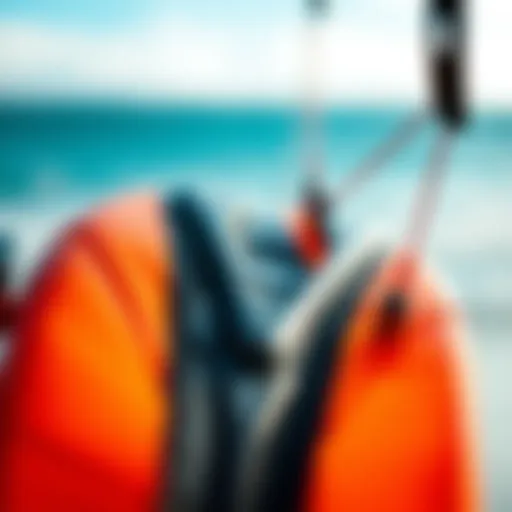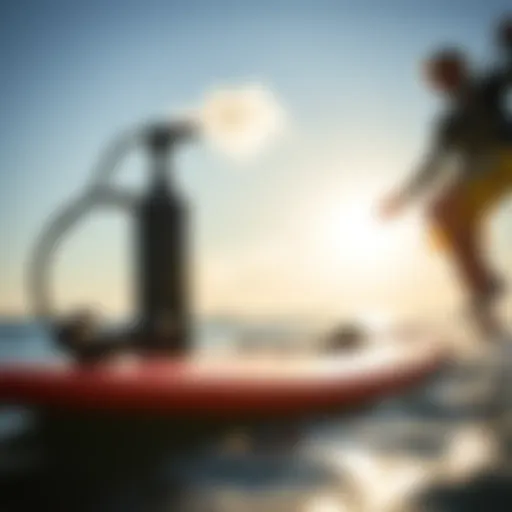The Kite Connector: Mastering Kiteboarding Gear and Skills


Intro
Kiteboarding has become a popular sport, capturing the hearts of thrill-seekers around the globe. What many may overlook, however, is the significance of the kite connector within this exhilarating activity. The kite connector not only affects the functionality of your gear but also heavily influences performance and safety.
Understanding this component is essential for kiteboarders at any level. From beginners just learning the ropes (or should I say, the lines?) to seasoned pros executing jaw-dropping tricks, being well-versed about kite connectors can elevate your kiteboarding experience.
In this article, we’ll delve into the primary aspects that shape kiteboarding gear, focusing particularly on the kite connector. We'll discuss various types of connectors, their essential functions, and the critical role they play in optimizing performance. Safety cannot be overlooked; thus, we’ll also outline the best practices to keep you upright and enjoying the ride.
Additionally, look forward to insights about gear maintenance, ensuring your connection remains as tight as a drum. Let's get started and navigate through the essentials of kiteboarding gear and techniques.
Understanding Kite Connectors
Kite connectors serve as a crucial link between an individual kite and the various components that facilitate an enjoyable and safe kiteboarding experience. While they may seem like a minor component in the grand scheme, understanding kite connectors can greatly enhance a kiteboarder’s performance and safety on the water. They enable the kite to interact effectively with the control bar, lines, and the overall kite system. A well-chosen connector ensures that the kite functions at its best, maintaining responsiveness and stability during flight.
Definition and Purpose
At its core, a kite connector is a specialized fastener designed to link the kite to the control bar and harness. These connectors facilitate the transfer of force from the kite to the rider, allowing for better control and maneuverability. They play an essential role in ensuring the rider’s safety, reliability, and performance. In kiteboarding, where the power of the wind can be unpredictable, choosing the right connector can make the difference between a thrilling ride and a dangerous situation. A connector not only must attach securely but also allows for easy release in emergencies, making them indispensable components of kiteboarding gear.
Historical Context
The evolution of kite connectors over the years is as interesting as the sport of kiteboarding itself. In the earlier days, kiteboarding enthusiasts often relied on makeshift solutions, using knots or simple carabiners to attach the kite to the lines. These rudimentary methods, while functional, posed risks, especially when sudden wind changes occurred. As the sport gained popularity, manufacturers began developing specialized connectors that prioritized both safety and efficiency.
By the late 1990s, innovations like quick-release mechanisms emerged, radically changing how connectors were viewed. Riders valued these advancements, as they allowed for quick disconnection from the kite in times of peril. This historical shift from basic attachments to sophisticated connectors reflects the increasing understanding of kite dynamics and rider safety. Today, a variety of kite connectors exist on the market, each offering distinct advantages and features, representing years of research and development focused on optimizing the kiteboarding experience.
Types of Kite Connectors
Understanding the various types of kite connectors is essential for anyone looking to maximize their kiteboarding experience. Each type of connector offers distinct benefits that can enhance both safety and performance on the water. Choosing the right kind is not just about preference; it can significantly influence how a kite reacts to various conditions and how easily a rider can manage their equipment. A well-informed decision about kite connectors can prevent not only frustrating situations but also potential accidents.
Quick Release Connectors
Quick release connectors are perhaps the most vital feature in modern kiteboarding safety mechanisms. Designed for rapid deployment, these connectors allow a rider to swiftly detach from the kite in emergency situations, such as when the kite is uncontrollable or when a rider is being pulled off into dangerous territory. This is especially crucial when dealing with sudden gusts or unexpected turns in wind conditions.
These connectors utilize a mechanism that allows the rider to release the connection with minimal effort. Riders can initiate this release with a simple pull, which can mean the difference between navigating back to shore safely or getting into a precarious situation. The design is intuitive, ensuring that even beginners can operate it without confusion.
Fixed Connectors
Fixed connectors, as the name suggests, provide a more permanent attachment between the kite and the lines. They are sturdy and reliable, ensuring that the kite remains firmly attached in all conditions. This type is often favored for its ability to withstand the stresses exerted during intense sessions or harsh environments.
While they do not allow for quick disconnect, fixed connectors can offer stability that quick-release options sometimes lack. There are no moving parts that could potentially fail, providing reassurance to more experienced riders who value reliability over rapid deployment. Understanding the trade-offs between fixed and quick-release connectors is essential for informed decision-making.
Universal Connectors
Universal connectors bridge the gap between different brands and models, offering kiteboarders a versatile option that works across various systems. This type of connector is particularly beneficial for those who may switch their gear often or who collaborate with friends who use different sets of equipment.
Compatibility Across Brands
One of the standout features of universal connectors is their compatibility across brands. This flexibility enables riders to mix and match their gear without being locked into one brand's ecosystem. Many riders appreciate this ability, as it often results in cost savings when searching for replacements or upgrades. A rider can change their kite without having to buy an entirely new set of connectors, which can be a costly affair.
However, compatibility comes with caveats. Not all universal connectors are created equal; some may not provide the same level of performance or safety due to design differences. Evaluating these connectors in relation to one's specific gear will yield better performance and a smoother experience overall.
Advantages and Disadvantages
When discussing the advantages and disadvantages of universal connectors, clarity becomes paramount. On one hand, their ability to work across multiple brands presents a significant advantage, especially for those who do not want to invest heavily in one company's products. Riders have access to a variety of kites and styles without shelling out for connectors each time.
However, it’s essential to consider potential drawbacks. Some universal connectors might not adhere as well to the specifications of each brand's provided safety features. This can sometimes lead to performance issues when the connector is not as precisely engineered for individual kites. Therefore, while universal connectors can be a cost-effective choice for many riders, careful research into their performance characteristics and a thorough comparison with specific brand options is advisable.


"In kiteboarding, the right connector can be the difference between fluid motions and a tangled mess. Don't overlook this vital aspect of your gear."
With a solid understanding of the types of kite connectors available, riders can make informed choices tailored to their personal needs, preferences, and riding styles.
Materials Used in Kite Connectors
When it comes to kiteboarding, the materials that make up the kite connectors play a fundamental role in both performance and safety. Understanding the differences between materials can help you make informed choices that impact your experience on the water, especially when the conditions get gnarly. Kite connectors are not just simple links; they're critical components that can make the difference between a smooth ride and a harrowing tumble along the shore.
Nylon vs. Metal Connectors
Nylon connectors are a popular choice among kiteboarders for their lightweight nature and flexibility. They tend to absorb impact without breaking, which can be particularly advantageous when the kite experiences sudden loads. But don’t let their soft touch fool you; they are surprisingly robust and often resistant to harsh weather conditions. However, metal connectors, typically made of aluminum or stainless steel, can offer superior strength and durability. They provide a reliable option for extreme conditions, where pummeling waves and high winds are part of the game.
Key Characteristics:
- Nylon: Flexible, lightweight, less prone to corrosion.
- Metal: Heavy-duty, higher load capacity, resistant to wear.
Advantages and Disadvantages:
- Advantages of Nylon: Reduced weight can prevent fatigue during extended sessions.
- Disadvantages of Nylon: They may not tolerate extreme conditions as well as metal connectors.
- Advantages of Metal: Longevity and strength make them a favorite among advanced riders.
- Disadvantages of Metal: Increased weight can lead to overexertion for less experienced users.
Durability Considerations
Impact of Environment
The environment plays a considerable role in determining the longevity of kite connectors. Exposure to saltwater, UV rays, and fluctuating temperatures can eat away at both nylon and metal connectors. Saltwater, in particular, is notorious for accelerating degradation. Riders who frequent coastal areas should pay close attention. Generally, connectors that are treated to resist corrosion and UV damage can outperform their untreated counterparts. This is why it’s essential to consider your local conditions when selecting gear. A little extra care goes a long way, especially when you’re mid-air, and the last thing you want is to be tethered to a faulty connector.
Maintenance Practices
Routine maintenance is integral to ensuring that kite connectors remain reliable. Regular cleaning, especially after sessions in saltwater, helps in tackling residue that can lead to rust or compromise the plastic integrity of connectors. Using warm water mixed with mild soap can work wonders; just be sure to rinse thoroughly afterward. It may sound simple, but neglecting these small practices can lead to premature wear and tear, risking not just equipment but also safety while surfing.
Key Maintenance Steps:
- Inspect connectors regularly for signs of wear.
- Always rinse off salt and sand after use.
- Store equipment in a shaded, dry place to prevent UV damage.
By understanding these materials and practices, kiteboarders can maximize not just their gear's lifespan but also their own safety. Adapting to the nuances of environmental impacts and committing to maintenance routines will contribute significantly to a more enjoyable and secure kiteboarding experience.
Technical Integration with Kite Systems
The connection between kite connectors and kite systems cannot be underestimated. This integration is critical for the overall performance and safety of kiteboarding activities. When kite connectors are well-suited to the system, riders can experience smoother operation, enhanced responsiveness, and increased safety on the water. The interplay between these components creates a synergy that directly influences a kiteboarder's experience.
Connecting to the Kite
The process of connecting the kite to its respective lines is fundamental. Kite connectors often utilize either a quick-release mechanism or a fixed method, each catering to specific user preferences and skill levels. For instance, a quick-release connector allows for swift detachment in cases of emergency. This immediate response can be a gamechanger when conditions turn unfriendly.
When attached correctly, these connectors enable the kite to harness wind power efficiently, allowing for dictation of direction and altitude. A mismatched connector can result in precarious situations. Those who are just jumping into the sport must pay special attention to the compatibility of their selected components. For example, connecting a high-performance kite with subpar connectors can lead to sluggish performance, denying the rider the thrill they seek.
"Connection to the kite must be secure and precise; there’s no room for error when navigating the winds."
Linking to the Control Bar
Linking the kite connectors to the control bar is another pivotal aspect of kiteboarding mechanics. The control bar serves as the nerve center for a kiteboarder, allowing them to adjust the kite’s position relative to the wind. This linkage must be robust and highly responsive. A connector that is difficult to manage can lead to miscommunication between the rider and their kite, especially during complex maneuvers.
Additionally, how a connector interacts with the control bar can affect the overall tuning of the kite’s performance. Different brands may call for different connector designs, and understanding these nuances ensures optimal kite responsiveness. A reliable connector minimizes inertia and allows for quick turns and dynamic actions without undue strain on the rider.
In summary, the integration of connectors with kite systems is more than just a mechanical necessity; it is a complex relationship fostering a safe and exhilarating kiteboarding experience.
Safety Features of Kite Connectors


Understanding the importance of safety features in kite connectors can’t be overstated. Whether you're a seasoned kiteboarder or just starting out, knowing that your gear can handle the unexpected is crucial. Kite connectors act as the bridge between you and your kite, so they need to be reliable. The implementation of effective safety mechanisms can markedly reduce the risk of accidents, ensuring a smoother experience on the water.
Built-in Safety Mechanisms
Every kite connector is designed with safety in mind. Many connectors come equipped with built-in safety mechanisms, which provide additional layers of protection during your ride. One common feature is the quick release system, crucial for emergency scenarios. If a rider finds themselves in a precarious situation—perhaps getting pulled too forcefully by the kite—activating this quick release enables swift detachment from the kite. This feature is often praised for its reliability, and can mean the difference between a minor mishap and a serious injury.
Additionally, some connectors have a safety leash that prevents complete disengagement. This means that even in a quick release scenario, the kite remains tethered to the rider. This dual-action approach helps to mitigate risks effectively, allowing for a safer experience overall.
Regular Inspections
To keep kite connectors functioning like a well-oiled machine, regular inspections are a must. As with any gear, wear and tear can occur over time, and without diligent checks, safety features might not perform as intended. Practicing routine inspections is not only a smart choice but can also prolong the lifespan of your equipment. Here are some crucial aspects to consider:
Identifying Wear and Tear
As kiteboarders, it’s essential to keep an eye out for signs of fatigue in your connectors. Identifying wear and tear can include visual inspections for fraying lines or any discolouration of materials. A key characteristic to focus on is the integrity of the quick-release mechanism— if it feels stiff or doesn't engage smoothly, that’s a potential red flag.
Additionally, mechanisms should be routinely cleaned to prevent dirt and salt from obstructing their functionality. Investing time in this aspect can be both beneficial and a worthwhile addition to your safety routine.
Replacement Guidelines
Knowing when to replace connectors is another critical element of kiteboarding safety. Connectors may not show obvious signs of deterioration, but if you’ve been using them for more than a few seasons, it might be time for a refresh. Frequent users should consider an annual check-up, whereas casual riders might extend this to every couple of years.
When choosing replacements, ensure compatibility with your existing gear to avoid added complications. A good practice is to keep a spare set handy, especially if you are planning a trip. It’s probably not ideal to discover a faulty connector while gearing up at the beach. In short, understanding the replacement guidelines will enable you to stay safer while boosting your confidence on the water.
Practical Use of Kite Connectors
Understanding how to effectively use kite connectors can mean the difference between a smooth day on the water and a frustrating experience. Practical use encompasses not only mechanical attachment but also the confidence in safety, performance, and overall kite control. Proper understanding and execution of this know-how enable kiteboarders—from novices to veterans—to harness the dynamics of the wind and waves more efficiently.
Proper Installation Techniques
The backbone of a successful kiteboarding session is the installation of kite connectors. It’s crucial to have a solid grasp on how to correctly attach these connectors to ensure maximum safety and performance. Here’s how to do it right:
- Read the Manual: First and foremost, each manufacturer’s connectors come with guidelines. Reading the manual is a step not to skip.
- Inspect the Equipment: Before installation, thoroughly examine all parts for wear, rust, or deformities. Look for cracks and annual checkups can save a trip to the hospital later.
- Choose the Right Connector: Depending on your kite’s specifications, choose between quick release or fixed connectors. Each has situations it excels in.
- Follow the Sequence: Lay out your setup in the correct sequence, connecting lines to the harness and reviewing your setup before launching.
- Test the Connection: After installation, perform a tug test. Gently pull on the connector to ensure it’s secure. If it’s loose, go back and tighten it.
By putting extra care into these steps, you reduce risks tremendously and set yourself up for a successful kiteboarding adventure. Safety isn’t just a checklist; it’s part of the thrill.
Troubleshooting Common Issues
Even the best-laid plans can hit snags. Knowing how to troubleshoot common issues with kite connectors is essential. Here are several of the most frequent problems and solutions that kiteboarders may encounter:
- Slipping Connectors: If you notice connectors slipping during use, make sure they are properly secured. Revisit installation instruction if necessary. In some cases, using tension bands may enhance grip.
- Wear and Tear on Connectors: Regularly inspect your connectors. Signs of wear include fraying or discoloration. If they look worse for wear, replace them before heading back out.
- Difficulty in Releasing Connectors: Sometimes, the quick release system might get jammed. If this happens, perform a systematic check for obstructions and dab a bit of lubricant if necessary. But avoid over-complicating things; if you feel uncertain, replace.
- Connector Compatibility Issues: It can be frustrating when connectors don’t fit as expected. Testing your gear together before hitting the water is wise. Collaborate with fellow kiteboarders to ensure you’ve got compatible gear.
"Tools are only as good as the user. Know your equipment inside out to make the most of your time in the water."
Navigating these issues efficiently can lead to a seamless kiteboarding experience. In both installation and troubleshooting, a little extra diligence can elevate your enjoyment and safety significantly.
Kite Connector Innovations
Innovations in kite connectors play an essential role in the evolution of kiteboarding. As the sport grows, so too does the need for equipment that enhances performance, reliability, and user experience. From beginners trying their hand at the sport to seasoned pros pushing their limits, advancements in kite connector technology can mean the difference between a mediocre session and an exhilarating ride.
Emerging Technologies
In recent years, kiteboarding has seen the introduction of high-tech materials and designs aimed at improving safety and efficiency. Traits like lightweight composites and adaptive designs are taking center stage. These innovations allow for a more responsive connection between the kite and rider, ensuring that movements are translated more effectively. Additionally, some models feature smart materials that respond to wind conditions, allowing for automatic adjustments. These technologies not only enhance performance but also contribute significantly to the sport’s safety features.
Future Trends in Kiteboarding Gear
Predictions for Connector Design


As we look to the horizon of kite connector development, several predictions stand out. One significant trend is the move towards modular designs. The idea here is that a single connector can be easily modified or adapted for different kites or skill levels. This flexibility would make connectors more appealing to a diverse range of kiteboarders, from novices who need simple setups to advanced users who value customization. Another aspect is the incorporation of data tracking and analytics into connectors, allowing riders to monitor performance in real-time. This feature would provide insights into riding styles, helping users refine their techniques over time. Effectively, these changes pave the way for a more personalized kiteboarding experience.
Impact on Performance
The impact of these connector innovations on performance is multifaceted. Enhanced connectors result in a more direct transmission of the kite’s power to the rider, enabling smoother rides and tighter turns. Additionally, connectors designed with shock-absorbing features can reduce strain on both the rider and the equipment. This is particularly important during high-stress maneuvers, where a malfunctioning connector could lead to accidents. Plus, with better materials holding everything together, durability is expected to rise, ensuring that equipment lasts longer—an appealing aspect for both budget-conscious beginners and high-level competitors alike.
"Investing in advanced kite connectors not only enhances performance but can also save costs long-term by reducing the need for frequent replacements."
User Experiences and Community Insights
User experiences and insights from the kiteboarding community play a vital role in shaping what gear works best and how it can be used effectively. Kiteboarders often have firsthand knowledge of the subtleties and quirks of particular connectors and equipment that aren’t covered in manuals. By tapping into collective experiences, one can gain practical knowledge that can save time, money, or even prevent safety issues down the line.
The value of real-world applications cannot be overstated. Real users provide detailed commentary on their equipment, the challenges faced, and the troubleshooting tips they’ve developed over time. This not only fosters a culture of shared learning but also builds a sense of community where individuals can support one another. Local forums and social media groups act as treasure troves of information, accommodating both novice kiteboarders seeking basics and seasoned pros sharing advanced tips.
Real-world Applications
Practical insights shared by kiteboarders often focus on how gear performs under various conditions. For instance, a certain quick-release connector might work like a charm in mild winds but may jam under high pressure. Such community knowledge ensures that newcomers understand not just the theory behind the gear but also its practical limitations, leading to better preparation and safety on the water.
The importance of location cannot be overlooked either; kiteboarding spots vary widely and can drastically affect gear performance. Enthusiasts often share updates regarding how equipment performs in different weather conditions, whether it's choppy waters or steady breezes. Taking these insights into account could mean the difference between an exhilarating session and a frustrating one.
Skill Level Perspectives
Beginner Experiences
The early trials and missteps of beginner kiteboarders form a critical part of the community narrative. Beginners often grapple with simple tasks like connecting lines properly or adjusting straps, which can seem daunting at first. However, these basic experiences help lay the foundation for an enjoyable kiteboarding journey.
The key characteristic of beginner experiences is their learning curve. It’s not uncommon for a newbie to struggle but ultimately transform those struggles into achievements. This process is a beneficial choice for anyone diving into the article, as many people can relate to learning through trial and error. Every beginner’s journey highlights the importance of patience and perseverance.
A unique feature of these experiences is the instinct for innovation that comes when faced with challenges, such as creating makeshift solutions when connectors malfunction. While this might lead to some frustrations, the advantages include gaining a better understanding of gear and how to optimize it effectively.
Advanced Applications
On the other side of the spectrum, advanced kiteboarders often refine their techniques and connectors to elevate their performance. Skilled riders usually have honed their gear selection process and know exactly what characteristics matter most for their specific style and conditions.
The key characteristic of advanced applications is the focus on precision. Proficient riders often prefer specific connector types that enhance performance—like quick-release connectors that maximize response time during tricky maneuvers. Their experiences can be incredibly useful for those looking to transcend the beginner phase and push into more complex tricks or conditions.
A unique feature of advanced applications is the sharing of feedback on the latest innovations. The downside, however, can be a steep learning curve for those who attempt to imitate advanced maneuvers without a solid understanding of the basics. Therefore, while the rewards can be incredible, new tricks come with risk, emphasizing the continual need for safety considerations in the sport.
"In kiteboarding, like in life, learning never stops. Each session brings new insights, whether you’re just starting out or are an old pro. "
In summary, the shared experiences and insights from the kiteboarding community significantly enrich the understanding of gear, techniques, and safety protocols. These perspectives inform better practices, foster community engagement, and create a shared treasure chest of knowledge that aids in the growth for kiteboarders at every level.
Culmination and Final Thoughts
In the expansive world of kiteboarding, the role of kite connectors becomes pivotal. This not only underpins the practical aspects of gear use but also speaks to the inherent safety and performance efficiencies essential for all kiteboarders. As you've seen throughout this article, kite connectors vary widely in type, functionality, and design, each serving a unique purpose that can dramatically influence the kiteboarding experience.
Understanding the nuances of these connectors is not merely informative; it's crucial for maximizing both fun and safety. As we explored, different types—be it quick release, fixed, or universal connectors—offer distinct advantages and considerations tied to performance outcomes and bail-out capabilities in uncertain situations. Not exclusively for seasoned kiteboarders, this information holds significant value for beginners who are starting to navigate the waters of kiteboarding.
Besides technical specifications, the emphasis on safety through regular use inspections cannot be overstated. Regular checks will help identify wear and tear, ensuring that every session is as secure as it is thrilling. Likewise, innovations in connector designs should inspire all kiteboarders. New developments frequently enhance usability and offer better performance, providing exciting paths forward for this already dynamic sport.
In sum, this exploration offers insight into the world of kite connectors that elevates our understanding. From choosing the right type to maintaining them effectively, each step enhances our kiteboarding journeys—ensuring that every ride is both exhilarating and safe.
Summarizing Key Points
The discussion of kite connectors has brought to light several key takeaways:
- Diverse Types of Connectors: Quick release, fixed, and universal connectors all serve different functions and should be chosen based on the specific needs of the rider.
- Materials Matter: The choice between nylon and metal greatly influences not only weight but also durability under various conditions.
- Safety is Paramount: Built-in mechanisms and regular inspections play an essential role in safeguarding kiteboarders.
- Community Insight: Real-world experiences shared among kiteboarding enthusiasts provide practical lessons on best practices and troubleshooting.
- Innovative Trends: Staying in touch with emerging technologies can shape the future kiteboarding gear environment.
Encouragement for Continued Learning
The world of kiteboarding is constantly evolving. As gears improve and techniques become more refined, there lies a treasure trove of knowledge waiting to be explored. It's vital, especially for those new to the sport, to remain curious and proactive in their learning journey. Embracing resources like community forums on reddit.com, or even engaging with fellow enthusiasts on facebook.com, can yield valuable insights that enhance proficiency.
Remember, becoming a better kiteboarder is not solely about mastering tricks but also understanding the intricacies of equipment, including connectors. Educational avenues abound—take courses, read articles, or watch videos from credible sources, perhaps even glancing at discussions on en.wikipedia.org or britannica.com, where foundational knowledge on related subjects can be deepened. The effort you put into learning today will pay off tomorrow, allowing you to tackle new challenges with confidence.















